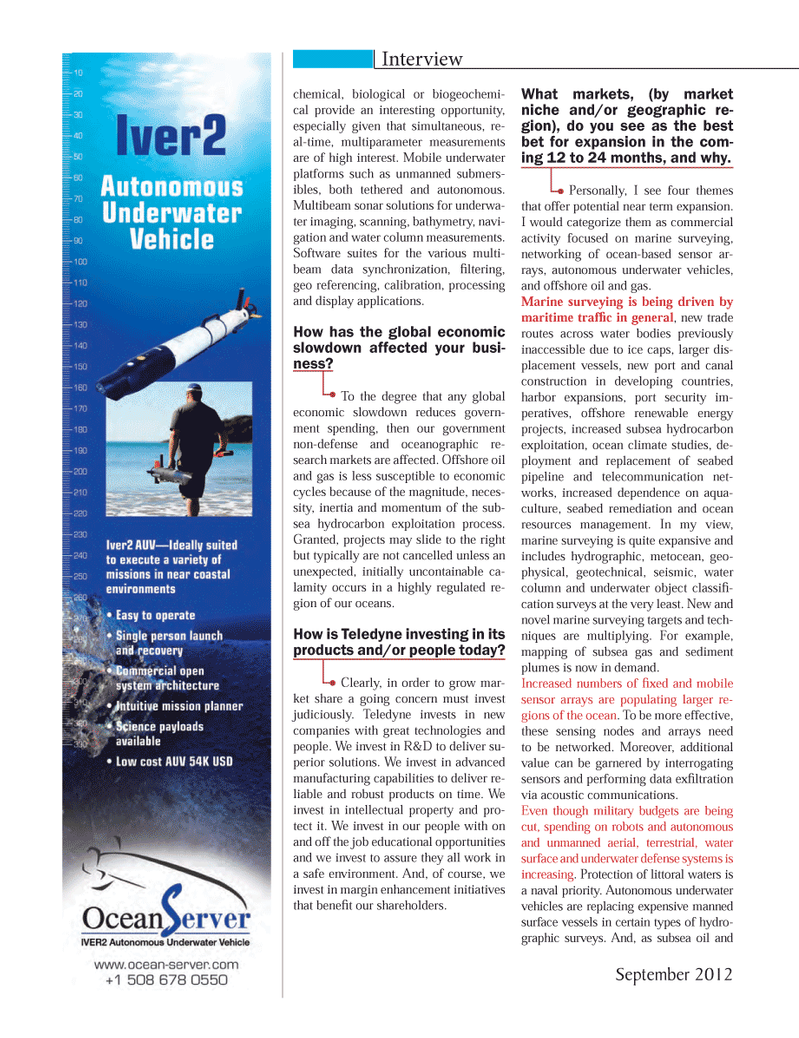
Page 24: of Marine Technology Magazine (September 2012)
Subsea Defense: Protecting Port & Subsea
Read this page in Pdf, Flash or Html5 edition of September 2012 Marine Technology Magazine
chemical, biological or biogeochemi-cal provide an interesting opportunity, especially given that simultaneous, re- al-time, multiparameter measurements are of high interest. Mobile underwater platforms such as unmanned submers-ibles, both tethered and autonomous. Multibeam sonar solutions for underwa- ter imaging, scanning, bathymetry, navi- gation and water column measurements. Software suites for the various multi- beam data synchronization, Þ ltering, geo referencing, calibration, processing and display applications.How has the global economic slowdown affected your busi- ness? To the degree that any global economic slowdown reduces govern- ment spending, then our government non-defense and oceanographic re-search markets are affected. Offshore oil and gas is less susceptible to economic cycles because of the magnitude, neces- sity, inertia and momentum of the sub- sea hydrocarbon exploitation process. Granted, projects may slide to the right but typically are not cancelled unless an unexpected, initially uncontainable ca- lamity occurs in a highly regulated re- gion of our oceans.How is Teledyne investing in its products and/or people today? Clearly, in order to grow mar- ket share a going concern must invest judiciously. Teledyne invests in new companies with great technologies and people. We invest in R&D to deliver su- perior solutions. We invest in advanced manufacturing capabilities to deliver re- liable and robust products on time. We invest in intellectual property and pro- tect it. We invest in our people with on and off the job educational opportunities and we invest to assure they all work in a safe environment. And, of course, we invest in margin enhancement initiatives that beneÞ t our shareholders. What markets, (by market niche and/or geographic re- gion), do you see as the best bet for expansion in the com- ing 12 to 24 months, and why. Personally, I see four themes that offer potential near term expansion. I would categorize them as commercial activity focused on marine surveying, networking of ocean-based sensor ar- rays, autonomous underwater vehicles, and offshore oil and gas. Marine surveying is being driven by maritime trafÞ c in general, new trade routes across water bodies previously inaccessible due to ice caps, larger dis- placement vessels, new port and canal construction in developing countries, harbor expansions, port security im- peratives, offshore renewable energy projects, increased subsea hydrocarbon exploitation, ocean climate studies, de- ployment and replacement of seabed pipeline and telecommunication net-works, increased dependence on aqua- culture, seabed remediation and ocean resources management. In my view, marine surveying is quite expansive and includes hydrographic, metocean, geo-physical, geotechnical, seismic, water column and underwater object classiÞ -cation surveys at the very least. New and novel marine surveying targets and tech- niques are multiplying. For example, mapping of subsea gas and sediment plumes is now in demand. Increased numbers of Þ xed and mobile sensor arrays are populating larger re- gions of the ocean. To be more effective, these sensing nodes and arrays need to be networked. Moreover, additional value can be garnered by interrogating sensors and performing data exÞ ltration via acoustic communications.Even though military budgets are being cut, spending on robots and autonomous and unmanned aerial, terrestrial, water surface and underwater defense systems is increasing. Protection of littoral waters is a naval priority. Autonomous underwater vehicles are replacing expensive manned surface vessels in certain types of hydro- graphic surveys. And, as subsea oil and Interview September 2012MTR #7 (18-33).indd 24MTR #7 (18-33).indd 249/10/2012 9:27:11 AM9/10/2012 9:27:11 AM

 23
23

 25
25
